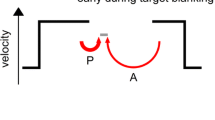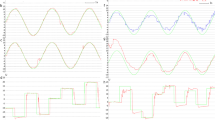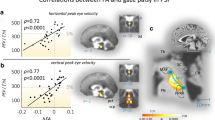Abstract
Parkinson’s disease (PD) is a progressive neurodegenerative disorder of the basal ganglia. Most PD patients suffer from somatomotor and oculomotor disorders. The oculomotor system facilitates obtaining accurate information from the visual world. If a target moves slowly in the fronto-parallel plane, tracking eye movements occur that consist primarily of smooth-pursuit interspersed with corrective saccades. Efficient smooth-pursuit requires appropriate target selection and predictive compensation for inherent processing delays. Although pursuit impairment, e.g. as latency prolongation or low gain (eye velocity/target velocity), is well known in PD, normal aging alone results in such changes. In this article, we first briefly review some basic features of smooth-pursuit, then review recent results showing the specific nature of impaired pursuit in PD using a cue-dependent memory-based smooth-pursuit task. This task was initially used for monkeys to separate two major components of prediction (image-motion direction memory and movement preparation), and neural correlates were examined in major pursuit pathways. Most PD patients possessed normal cue-information memory but extra-retinal mechanisms for pursuit preparation and execution were dysfunctional. A minority of PD patients had abnormal cue-information memory or difficulty in understanding the task. Some PD patients with normal cue-information memory changed strategy to initiate smooth tracking. Strategy changes were also observed to compensate for impaired pursuit during whole body rotation while the target moved with the head. We discuss PD pathophysiology by comparing eye movement task results with neuropsychological and motor symptom evaluations of individual patients and further with monkey results, and suggest possible neural circuits for these functions/dysfunctions.






(adapted from Cui et al. 2003). Pink and green arrows in e schematically illustrate the possible circuits that include SEF, oculomotor vermis, caudal fastigal nuclei and vestibular nuclei for no-go instruction specific discharge during delay 2 of memory-based pursuit/saccade task. Reproduced and modified from Kurkin et al. (2014)
Similar content being viewed by others
References
Ashby FG, Turner BO, Horvitz JC (2010) Cortical and basal ganglia contributions to habit learning and automaticity. Trends Cogn Sci 14:208–215
Barnes GR (2008) Cognitive processes involved in smooth pursuit eye movements. Brain Cogn 68:309–326
Barnes GR, Collins CJS (2008a) The influence of briefly presented randomised target motion on the extra-retinal component of ocular pursuit. J Neurophysiol 99:831–842
Barnes GR, Collins CJS (2008b) Evidence for a link between the extra-retinal component of random-onset pursuit and the anticipatory pursuit of predictable object motion. J Neurophysiol 100:1135–1146
Basso MA, Pokorny JJ, Liu P (2005) Activity of substantia nigra pars reticulata neuons during smooth pursuit eye movements in monkeys. Eur J Neurosci 22:448–464
Bichot NP, Schall JD (2002) Priming in macaque frontal cortex during popout visual search: feature-based facilitation and location-based inhibition of return. J Neurosci 22:4675–4685
Buhusi CV, Meck WH (2005) What makes us tick? Functional and neural mechanisms of interval timing. Nat Rev Neurosci 6:755–765
Coppe S, Orban de **vry JJ, Yüksel D, Ivanoiu A, Lefèvre P (2012) Dramatic impairment of prediction due to frontal lobe degeneration. J Neurophysiol 108:2957–2966
Cui DM, Yan YJ, Lynch JC (2003) Pursuit subregion of frontal eye field projects to the caudate nucleus in monkeys. J Neurophysiol 89:2678–2684
Fukushima K, Sato T, Fukushima J, Shinmei Y, Kaneko CRS (2000) Activity of smooth pursuit-related neurons in the monkey periarcuate cortex during pursuit and passive whole body rotation. J Neurophysiol 83:563–587
Fukushima K, Yamanobe T, Shinmei Y, Fukushima J (2002) Predictive responses of peri-arcuate pursuit neurons to visual target motion. Exp Brain Res 145:104–120
Fukushima J, Akao T, Takeichi N, Kurkin S, Kaneko CR, Fukushima K (2004) Pursuit-related neurons in the supplementary eye fields: discharge during pursuit and passive whole body rotation. J Neurophysiol 91:2809–2825
Fukushima J, Akao T, Shichinohe N, Kurkin S, Kaneko CRS, Fukushima K (2011a) Neuronal activity in the caudal frontal eye fields of monkeys during memory-based smooth-pursuit eye movements: comparison with the supplementary eye fields. Cereb Cortex 21:1910–1924
Fukushima K, Fukushima J, Warabi T (2011b) Vestibular-related frontal cortical areas and their roles in smooth-pursuit eye movements: representation of neck velocity, neck-vestibular interactions and memory-based smooth-pursuit. Front Neurol 2:1–26. doi:10.3389/fneur.2011.00078
Fukushima K, Fukushima J, Warabi T, Barnes GR (2013) Cognitive processes involved in smooth pursuit eye movements: behavioral evidence, neural substrate and clinical correlation. Front Syst Neurosci 7(4):1–28. doi:10.3389/fnsys.2013.00004
Fukushima K, Barnes GR, Ito N, Olley PM, Warabi T (2014) Normal aging affects movement execution but not visual motion working memory and decision-making delay during cue-dependent memory-based smooth-pursuit. Exp Brain Res 232:2369–2379
Fukushima K, Ito N, Barnes GR, Onishi S, Kobayashi N, Takei H, Olley PM, Chiba S, Inoue K, Warabi T (2015) Impaired smooth-pursuit in Parkinson’s disease: normal cue-information memory, but dysfunction of extra-retinal mechanisms for pursuit preparation and execution. Physiol Rep 3(3):e12361, doi:10.14814/phy2.12361
Furuya N, Kawano K, Shimazu H (1976) Transcerebellar inhibitory interaction between bilateral vestibular nuclei. Exp Brain Res 25:447–463
Garbutt S, Lisberger SG (2006) Directional cuing of target choice in human smooth pursuit eye movements. J Neurosci 26:12479–12486
Goldberg JM, Wilson VJ, Cullen KE, Angelaki DE, Broussard DM, Büttner-Ennever JA, Fukushima K, Minor LB (2012) The vestibular system. A sixth sense. Oxford Univ Press, New Yourk
Helmchen CH, Pohlmann J, Trillenberg P, Lencer R, Graf J, Sprenger A (2012) Role of anticipation and prediction in smooth pursuit eye movement. Mov Disord 27:1012–1018
Hikosaka O, Takikawa Y, Kawagoe R (2000) Role of the basal ganglia in the control of purposive saccadic eye movements. Physiol Rev 80:953–978
Hikosaka O, Nakamura K, Sakai K, Nakahara H (2002) Central mechanisms of motor skill learning. Curr Opn Neurobiol 12:217–222
Ito M (1984) The cerebellum and neural control. Raven Press, New York
Ito N, Ikeno K, Kobayashi N, Takei H, Olley PM, Chiba S, Inoue K, Fukushima K, Warabi T (2011) Clinical application of a memory- based smooth pursuit eye movement (SPEM) task to patients with idiopathic Parkinson’s disease (PD) and patients with frontal dysfunction. Neurosci Res 71 (Suppl):e145
Ito N, Barnes GR, Fukushima J, Fukushima K, Warabi T (2013) Cue-dependent memory-based smooth-pursuit in normal human subjects: importance of extra-retinal mechanisms for initial pursuit. Exp Brain Res 229:23–35
Ito N, Takei H, Chiba S, Inoue K, Fukushima K (2016a) Visual tracking with/without passive whole-body rotation in Parkinson’s disease (PD): dissociation of smooth-pursuit and cancellation of vestibulo-ocular reflex (VOR). Clin Neurol 56:158–164
Ito N, Takei H, Chiba S, Fukushima K (2016b) Frontal cortical dysfunction in Parkinson’s disease (PD): comparison of memory-based smooth-pursuit and anti-saccade tasks, and neuropsychological and motor symptom evaluations. Clin Neurol 56:747–753
Jarrett CB, Barnes GR (2002) Volitional scaling of anticipatory ocular pursuit velocity using precues. Cog Brain Res 14:383–388
Kurkin S, Akao T, Shichinohe N, Fukushima J, Fukushima K (2011) Neuronal activity in Medial Superior Temporal area (MST) during memory-based smooth pursuit eye movements in monkeys. Exp Bain Res 214:293–301
Kurkin S, Akao T, Fukushima J, Shichinohe N, Kaneko CRS, Belton T, Fukushima K (2014) No-go neurons in the cerebellar oculomotor vermis and caudal fastigial nuclei: planning tracking eye movements. Exp Brain Res 232:191–210
Kyuhou S, Kawaguchi S (1987) Cerebellocerebral projection from the fastigial nucleus onto the frontal eye field and anterior ectosylvian visual area in the cat. J Comp Neurol 259:571–590
Lee E-Y, Cowan N, Vogel EK, Rolan T, Valle-Inclan F, Hackley SA (2010) Visual working memory deficits in patients with Parkinson’s disease are due to both reduced storage capacity and impaired ability to filter out irrelevant information. Brain 133:2677–2689
Leigh RJ, Zee DS (2015) The neurology of eye movements, 5th edn. Oxford Univ Press, New York
Lekwuwa GU, Barnes GR (1996) Cerebral control of eye movements: II. timing of anticipatory eye movements, predictive pursuit, and phase errors in focal cerebral lesions. Brain 119:491–505
Leventhal AG, Wang YC, Pu ML, Zhou YF, Ma YY (2003) GABA and its agonists improved visual cortical function in senescent monkeys. Science 300:812–815
Lisberger SG (1995) Visual tracking in monkeys: evidence for short-latency suppression of the vestibuloocular reflex. J Neurophysiol 63:676–688
Lisberger SG, Ferrera VP (1997) Vector averaging for smooth pursuit eye movements initiated by two moving targets in monkeys. J Neurosci 17:7490–7502
Lynch JC, Tian J-R (2006) Cortico-cortical networks and cortico-subcortical loops for the higher control of eye movements. Prog Brain Res 151:461–501
Mahaffy S, Krauzlis RA (2011) Inactivation and stimulation of the frontal pursuit area change pursuit metrics without affecting pursuit target selection. J Neurophysiol 106:347–360
Mak E, Su L, Williams GB, Firbank MJ, Lawson RA, Yarnall AJ, Duncan GW, Owen AM, Khoo TK, Brooks DJ, Rowe JB, Barker RA, Burn DJ, O’Brien JT (2015) Baseline and longitudinal grey matter changes in newly diagnosed Parkinson’s disease: ICICLE-PD study. Brain 138:2974–2986
Noda H, Sugita S, Ikeda Y (1990) Afferent and efferent connections of the oculomotor region of the fastigial nucleus in the macaque monkey. J Comp Neurol 302:330–348
O’Callaghan C, Hornberger M, Balsters JH, Halliday GM, Lewis SJ, Shine JM (2016) Cerebellar atrophy in Parkinson’s disease and its implication for network connectivity. Brain 139:845–855
Phillips JO, Finoccio, Ong L, Fuchs AF (1997) Smooth pursuit in 1- to 4-month-old human infants. Vis Res 37:3009–3020
Possin KL, Filoteo JV, Song DD, Salmon DP (2008) Spatial and object working memory deficits in Parkinson’s disease are due to impairment in different underlying processes. Neuropsychol 22:585–595
Rascol O, Clanet M, Montastruc JL, Simonetta M, Soulier-Esteve MJ, Doyon B, Rascol A (1989) Abnormal ocular movements in Parkinson’s disease. Evidence for involvement of dopaminergic systems. Brain 112:1193–1214
Redgrave P, Rodriguez M, Smith Y, Rodriguez-Oroz MC, Lehericy S, Bergman H, Agid Y, DeLong MR, Obesso JA (2010) Goal-directed and habitual control in the basal ganglia: implications for Parkinson’s disease. Nat Rev Neurosci 11:760–772
Salman MS, Sharpe JA, Lillakas L, Dennis M, Steinbach MJ (2006) Smooth pursuit eye movements in children. Exp Brain Res 169:139–143
Shibasaki H, Tsuji S, Kuroiwa Y (1979) Oculomotor abnormalities in Parkinson’s disease. Arch Neurol 36:360–364
Shichinohe N, Akao T, Kurkin S, Fukushima J, Kaneko CRS, Fukushima K (2009) Memory and decision making in the frontal cortex during visual motion processing for smooth pursuit eye movements. Neuron 62:717–773
Takeichi N, Fukushima J, Kurkin S, Yamanobe T, Shinmei Y, Fukushima K (2003) Directional asymmetry in smooth ocular tracking in the presence of visual background in young and adult primates. Exp Brain Res 149:380–390
Tanaka M (2005) Involvement of the central thalamus in the control of smooth pursuit eye movements. J Neurosci 25:5866–5876
Tanaka M, Fukushima K (1998) Neuronal responses related to smooth pursuit eye movements in the periarcuate cortical area of monkeys. J Neurophysiol 80:28–47
Waterston JA, Barnes GR, Grealy MA, Collins S (1996) Abnormalities of smooth eye and head movement control in Parkinson’s disease. Ann Neurol 39:749–760
White OB, Saint-Cyr A, Sharpe JA (1983) Ocular motor deficits in Parkinson’s disease. I. The horizontal vestibulo-ocular reflex and its regulation. Brain 106:555–570
Wu T, Hallet M (2013) The cerebellum in Parkinson’s disease. Brain 136:696–709
Yang S, Heinen S (2014) Contrasting the roles of the supplementary and frontal eye fields in ocular decision making. J Neurophysiol 111:2644–2655
Yoshida A, Tanaka M (2009) Neuronal activity in the primate globus pallidus during smooth pursuit eye movements. Neuroreport 20:121–125
Author information
Authors and Affiliations
Corresponding author
Rights and permissions
About this article
Cite this article
Fukushima, K., Fukushima, J. & Barnes, G.R. Clinical application of eye movement tasks as an aid to understanding Parkinson’s disease pathophysiology. Exp Brain Res 235, 1309–1321 (2017). https://doi.org/10.1007/s00221-017-4916-5
Received:
Accepted:
Published:
Issue Date:
DOI: https://doi.org/10.1007/s00221-017-4916-5




